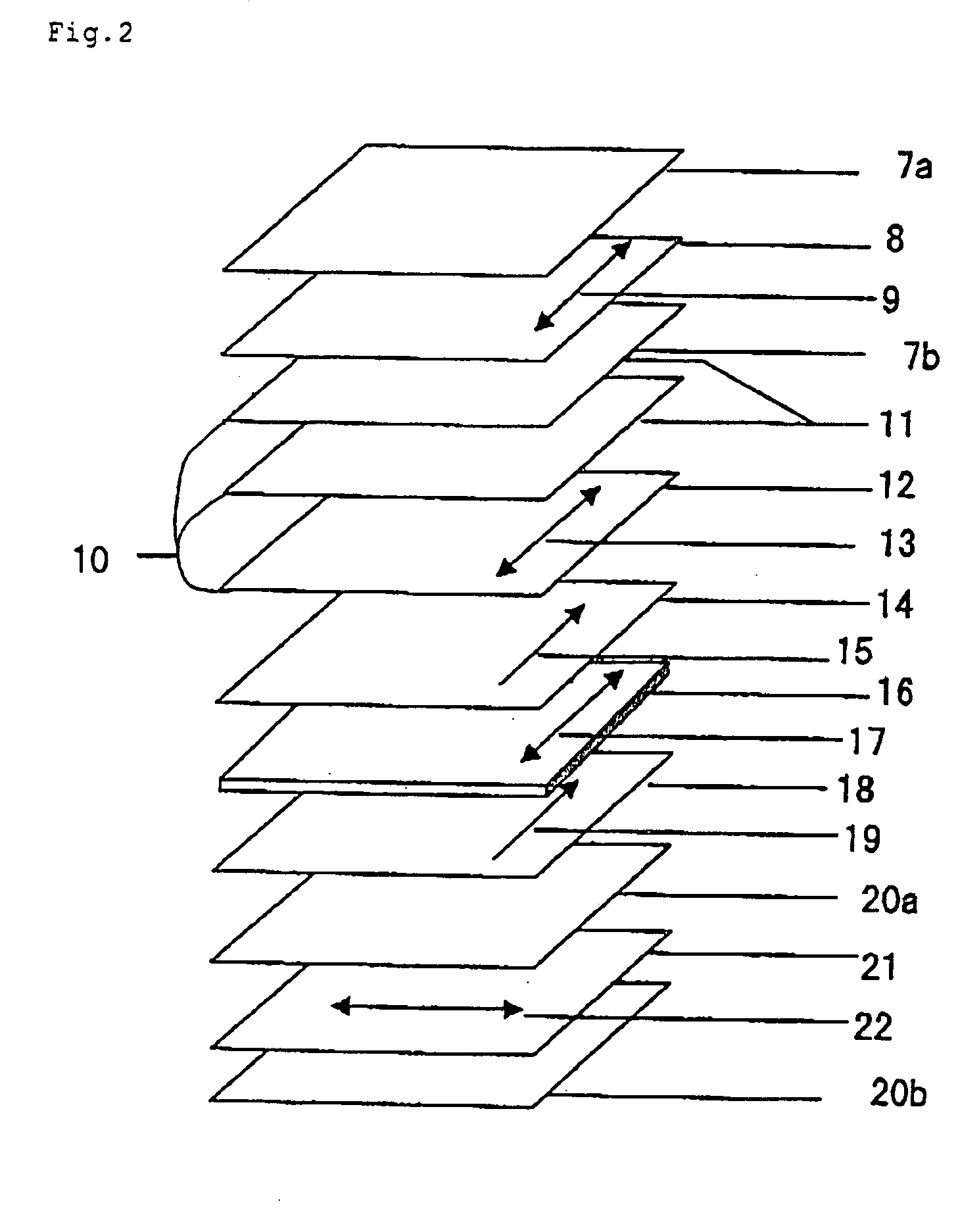Composition, optical compensatory film and liquid crystal display
a liquid crystal display and film technology, applied in the field of liquid crystal display, can solve the problems of lowering display quality, difficult to optically compensate liquid crystal cells perfectly, and inability to avoid contrast inversions generating at under areas of images, etc., to achieve simple configuration, improve viewing angle, not only display quality
- Summary
- Abstract
- Description
- Claims
- Application Information
AI Technical Summary
Benefits of technology
Problems solved by technology
Method used
Image
Examples
example 1
[0232] An electrode shown in FIG. 1 was formed on a glass plate so that the distance between the electrodes was 20 μm, and a polyimide film was formed on the electrode and subjected to rubbing treatment. The rubbing treatment was carried out in a direction shown in FIG. 1. A polyimide film was formed on another glass plate and subjected to rubbing treatment to form an alignment layer. Two such glass substrates were positioned with their alignment layers facing with their rubbing directions being parallel to each other and with a 3.9 micrometer gap between them. Nematic liquid-crystal composition, having a refractive-index anisotropy, Δn, of 0.0769 and a dielectric-constant anisotropy, Δe, of 4.5, was poured into the gap between the substrates to form a liquid-crystal layer. The d·Δn of the layer was 300 nm.
(Preparation of First Retardation Area)
[0233] The following components were charged to a mixing tank and stirred with heating to prepare a cellulose acetate solution (dope).
[0...
example no.2
Example No. 2
[0244] A commercially available cellulose acetate film (“FUJITAC TD80UF” manufactured by FUJI PHOTO FILM CO., LTD.), having a Re of 3 nm and a Rth of 45 nm, was used as a first retardation area. The film was saponified, and the coating liquid for an alignment layer, prepared in the same manner of Examples 1, was applied to the saponified surface with a wire-bar coater in an amount of 20 ml / m2, dried with hot air of 60° C. for 60 seconds, and subsequently dried with hot air of 100° C. for 120 seconds to form a polymer layer. Next, the polymer layer was subjected to rubbing treatment in a direction parallel to the slow axis of the film to form an alignment layer.
[0245] Subsequently, a coating solution was prepared in the same manner of Example 1, or in other words prepared by dissolving 1.8 g of a liquid-crystal compound shown above, 0.2 g of ethylene oxide-modified trimethyrol propane triacrylate (V#360 made by Osaka Organic Chemicals (Ltd.), 0.06 g of a polymerization ...
example 3
[0250] A commercially available cellulose acetate film (“FUJITAC TD80UF” manufactured by FUJI PHOTO FILM CO., LTD.), having a Re of 3 nm and a Rth of 45 nm, was saponified, and a coating liquid, which was prepared by diluting a commercially available vertical alignment layer (“JALS-204R” manufactured by JSR Corporation) with methyl ethyl ketone in a ratio of 1:1, was applied to a saponified surface of the cellulose acetate film with a wire-bar coater in an amount of 2.4 ml / m2; and immediately, dried with hot air of 120° C. for 120 seconds.
(Preparation a Layer in Which Rod-Like Liquid-Crystal Molecules are Aligned Vertically)
[0251] A coating solution was prepared by dissolving 1.8 g of a liquid-crystal compound shown below, 0.06 g of a polymerization initiator (IRGACURE 907 manufactured by Ciba-Geigy), 0.02 g of a sensitizer (KAYACURE-DETX manufactured by NIPPON KAYAKU CO., LTD.) and 0.002 g of a vertical alignment agent at an air-interface sown below in 9.2 g of methyl ethyl keto...
PUM
| Property | Measurement | Unit |
|---|---|---|
| angle | aaaaa | aaaaa |
| angle | aaaaa | aaaaa |
| angle | aaaaa | aaaaa |
Abstract
Description
Claims
Application Information
 Login to View More
Login to View More - R&D
- Intellectual Property
- Life Sciences
- Materials
- Tech Scout
- Unparalleled Data Quality
- Higher Quality Content
- 60% Fewer Hallucinations
Browse by: Latest US Patents, China's latest patents, Technical Efficacy Thesaurus, Application Domain, Technology Topic, Popular Technical Reports.
© 2025 PatSnap. All rights reserved.Legal|Privacy policy|Modern Slavery Act Transparency Statement|Sitemap|About US| Contact US: help@patsnap.com



